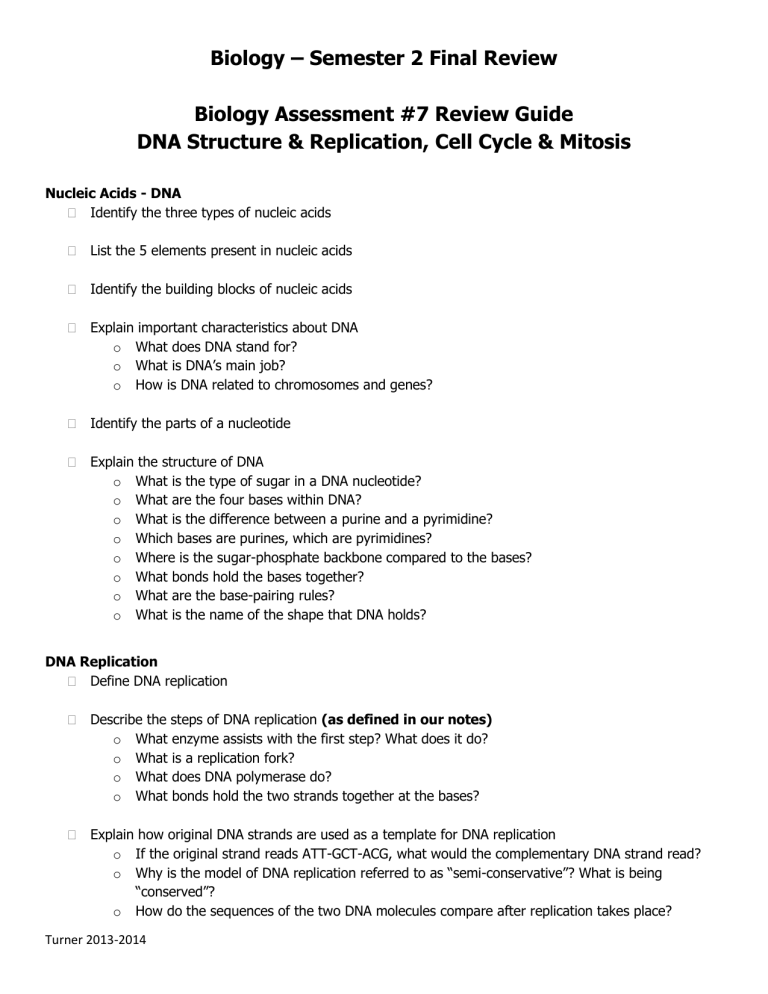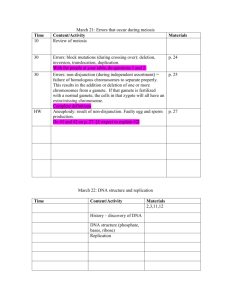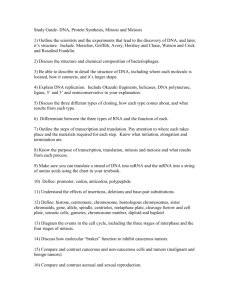Biology – Semester 2 Final Review Biology Assessment #7 Review

Biology – Semester 2 Final Review
Biology Assessment #7 Review Guide
DNA Structure & Replication, Cell Cycle & Mitosis
Nucleic Acids - DNA
Identify the three types of nucleic acids
List the 5 elements present in nucleic acids
Identify the building blocks of nucleic acids
Explain important characteristics about DNA o What does DNA stand for? o What is DNA’s main job? o How is DNA related to chromosomes and genes?
Identify the parts of a nucleotide
Explain the structure of DNA o What is the type of sugar in a DNA nucleotide? o What are the four bases within DNA? o What is the difference between a purine and a pyrimidine? o Which bases are purines, which are pyrimidines? o Where is the sugar-phosphate backbone compared to the bases? o What bonds hold the bases together? o What are the base-pairing rules? o What is the name of the shape that DNA holds?
DNA Replication
Define DNA replication
Describe the steps of DNA replication (as defined in our notes) o What enzyme assists with the first step? What does it do? o What is a replication fork? o What does DNA polymerase do? o What bonds hold the two strands together at the bases?
Explain how original DNA strands are used as a template for DNA replication o If the original strand reads ATT-GCT-ACG, what would the complementary DNA strand read? o Why is the model of DNA replication referred to as “semi-conservative”? What is being
“conserved”? o How do the sequences of the two DNA molecules compare after replication takes place?
Turner 2013-2014
Cell Reproduction: Binary Fission & The Cell Cycle
Identify the difference between prokaryotic DNA and eukaryotic DNA o Where are the two located? What is different about their shapes?
Describe the steps of binary fission o How do the offspring (“children”) compare to the original cell? o What types of organisms use binary fission?
List reasons for why new cells need to be made for eukaryotes
Define “The Cell Cycle” for eukaryotes
Compare and contrast chromatin, chromosomes, and chromatids o During what part of the Cell Cycle are these forms of DNA present?
List the phases of the cell cycle and give a brief description of the occurrences in each phase o What three parts make up Interphase? o What is the difference between mitosis and cytokinesis?
Mitosis Circles + Plant vs. Animals
Identify and describe the four phases of mitosis o What structures are involved during each step? o What shape/form is the DNA in during each stage?
Differentiate between animal and plant cells during telophase o What structure makes the last phase of mitosis different for animal and plant cells? o What is it called in animal cells where the cell membrane is being pinched to form two separate cells? o What structure in plant cells eventually becomes the cell wall between two newly separated
Explain how control of cell division is an example of negative feedback cells?
Biology Assessment #8 Review Guide
Meiosis, Chromosomes & Karyotypes, Non-disjunction,
Fertilization & Differentiation
Meiosis
Identify (name) and describe the eight phases of meiosis (PMAT I and PMAT II) o What structures are involved during each step? o What shape/form is the DNA in during each stage? o What events/processes (2) contribute to genetic variability in the daughter cells?
Turner 2013-2014
o How many chromosomes does each daughter cell have by the end of meiosis? (You can use humans as an example, but in general how many chromosomes would it have compared to the parent cell?)
Compare and contrast the processes of mitosis and meiosis o Consider the following characteristics – number of chromosomes in daughter cells compared to parent cell (diploid or haploid), number of daughter cells, type of daughter cells, involved in what type of reproduction, number of phases, events within stages. o How are the GOALS of meiosis and mitosis different?
Chromosomes and Karyotypes
Explain the difference between the different forms of DNA and identify the stages in which they are present o What is chromatin? o What is the difference between a double stranded chromosome and a single stranded chromosome? o What are sister chromatids? o What are homologous chromosomes?
Identify the two types of chromosomes o How many are there of each? o Which combination of sex chromosomes would result in a human male? Human female?
Identify the two types of cells
Explain the difference between a diploid and haploid cell o What types of cells are diploid and what types are haploid? o What does the notation 2n and n mean?
Describe a karyotype o What can it be used to identify?
Define aneuploidy
Distinguish between monosomy and trisomy o What are examples of chromosomal disorders in humans that are caused by monosomy and trisomy? (Need to know Turner’s syndrome, Down syndrome, and Klinefelter’s syndrome)
Non-disjunction, Fertilization, and Differentiation
Define non-disjunction
Identify the stages of meiosis in which non-disjunction could occur
Describe how daughter cells of meiosis would be different if non-disjunction occurred o What does (n+1) and (n-1) refer to? How is this different from (2n+1) and (2n-1)
Turner 2013-2014
o In what cases would the cells or individuals not be able to survive? Are there cases that they would survive? What are these?
Define and briefly describe oogenesis and spermatogenesis o How are they different from each other (location, process)? o How many useable eggs are produced to useable sperm?
Define fertilization o How does fertilization restore the diploid number in humans (and other diploid organisms)?
Describe the difference between zygote, embryo, and fetus
Define differentiation o How do you think having different specialized cells help an organism be more efficient?
Biology Assessment #9 Review Guide
Genetics and Monohybrid & Dihybrid Crosses
Introduction to Genetics
Define genetics
Define trait
Identify the Mendel's principle findings on the patterns of genetics (inheritance patterns) o What does it mean for a trait to be dominant or recessive? o What does the Law of Segregation state? How is this shown during meiosis? o What does the Law of Independent Assortment state? When does this occur during meiosis?
Define genotype and phenotype o What is an allele? o How is genotype used to determine phenotype?
Distinguish between a homozygous genotype and a heterozygous genotype o How is a homozygous dominant genotype different from a homozygous recessive genotype?
Monohybrid & Dihybrid Crosses
Identify the purpose of a Punnett square o How is the Law of Segregation demonstrated while using a Punnett square? o How does this demonstrate the Law of Independent Assortment? o How is fertilization demonstrated while using a Punnett square? o Why is it important to realize that this is a PROBABILITY and not a certainty?
Turner 2013-2014
Use a Punnett square to show the possible genotypes of the offspring in a monohybrid cross
Calculate the genotypic and phenotypic ratio for a monohybrid cross
Define monohybrid cross and dihybrid cross
Determine the possible gametes from a parental genotype representing two traits
Use a Punnett square to show the possible genotypes of the offspring in a dihybrid cross
Calculate the genotypic and phenotypic ratio for a dihybrid cross
Biology Assessment #10 Review Guide
Protein Synthesis & Mutations
Proteins
Identify the three categories that proteins fall in to o What is an example of a protein for each of these categories?
Identify what enzymes do
Identify the building blocks of proteins o How many types of these building blocks are there? o Where do they come from? (How do we or other living things get them?) o What do we call a chain of these building blocks? o What types of bonds hold them together in a chain?
Transcription (Protein Synthesis)
Identify the three processes that make up the Central Dogma
Explain the result of the process of transcription
Identify three structural differences between DNA and RNA
Identify and describe the jobs of the three different types of RNA
Describe the steps of transcription o Where does this process take place? o What molecules are involved in this process? o What does RNA polymerase do?
Identify the sequence of mRNA that would result from a template strand of DNA
Turner 2013-2014
o Example: What would the mRNA sequence be for a strand of DNA that reads AATGCTATAGCC
Compare and contrast between DNA Replication and Transcription o How are they different in terms of how much and how often these process happen?
Translation (Protein Synthesis)
Explain the result of the process of translation
Identify what a codon is, where it is located, and what it codes for o Which type of RNA contains codons? Which type contains anticodons? o What is THE start codon? What amino acid does it code for? o What are stop codons for? Which codons are stop codons? o Explain why this phrase makes sense: Each codon codes for an amino acid, but not every amino acid has its own amino acid.
Explain the basic structure of the ribosome o Which subunit binds to which type of RNA?
Describe the steps involved in translation o How does the tRNA molecule “know” which amino acid to bring next? How does base-pairing rules play a part in this? o How does the ribosome help in this process? o What signals for translation to begin? To end?
Identify what happens to the polypeptide chain once translation is complete
Mutations
Define mutation
Identify different causes of mutations o Why do you think it’s more common for induced mutations to happen compared to naturally occurring ones?
Define point mutation
Identify and describe the three types of point mutations o Which type of point mutation would most likely cause the biggest problem for protein synthesis?
Identify what causes cancer o How is this related to mitosis?
Explain the difference between a somatic cell mutation and a sex cell mutation o In what type of cell would we be able to pass on a mutation?
Turner 2013-2014
Identify the ways that mutations would or would not affect the phenotype of an individual (trait that is expressed)
Biology Assessment #11 Review Guide
Cancer & Biotechnology
Understanding Cancer – NIH Videos
Describe the roles of tumor suppressor genes and proto onco genes
Cancer (The Cancer/Mitosis Connection)
Describe how the rate of cell division is related to cancer
Identify examples of different rates of division for different cells o How are these rates “appropriate” for that particular cell type? o What stage of the cell cycle do cells spend most of their time in?
Identify how the rate of cell division (or cell growth) is regulated o What happens when this process is disrupted?
Describe the consequences of increased rates of mitosis
Identify different causes of cancer (be prepared to identify specific examples) o Extra – does all types of radiation cause cancer? Which types do – high energy radiation or low energy radiation?
Define carcinogen o What does it mean that exposure to carcinogens is cumulative? o What do carcinogens do?
Identify the two types of tumors o Which is the dangerous type? Why is it considered dangerous?
Describe how cancer cells affect neighboring cells
Identify and describe the different options for cancer treatment
Biotechnology
Identify the purpose of gel electrophoresis o What properties about the molecules allow them to move across the gel at faster or slower rates? o What is being applied to the molecules to make them move? o What is present in each band on the gel electrophoresis?
Turner 2013-2014
Describe the steps for using gel electrophoresis o Where do you place the samples and with what piece of equipment? o What could be in the samples?
Identify the molecular properties that mostly determine the rate at which those molecules travel through a gel during gel electrophoresis o What charge does DNA and RNA possess? Extra – what gives them this charge? o Which end will these nucleic acids move toward? What is this electrode called?
Identify and explain the reason why polysaccharide agarose is used to make the gels o What if the two molecules are the same size, what else could make them move faster or slower?
Identify the roles of the buffer
Identify potential uses for gel electrophoresis
Biology Assessment #12 Review Guide
Biological Evolution
Biological Evolution
Describe how a population can evolve instead of an individual organism
Identify and describe Lamarck’s theory of evolution o What is an “acquired” characteristic? How does your knowledge of genes help to explain that acquired characteristics can’t be passed down? o Use an example organism to describe how Lamarck thought biological evolution occurred.
(Giraffe used on powerpoint)
Identify and describe Darwin and Wallace’s theory of evolution o How does variation play a role in the theory? o Why is reproduction so important?
Define evolution
Identify and describe factors that can change gene frequency in a population or species over time (3 mentioned)
Identify and explain the three tenets of the theory of evolution
Apply these three tenets of the theory of evolution to an example scenario/organism
Identify causes of (genetic) variation o Is variation directional? What does that mean?
Turner 2013-2014
o What must be true about a mutation for it to be passed on to offspring?
Define differential survival o Is the “selection process” directional? What does that mean?
Define genetic drift o Can you apply this concept to a real-life population? Try it.
Define speciation o What is the definition we use for a species in biology? (it’s not perfect…but it’s what we’ve got!)
List/describe steps that could lead to a new species o Apply these steps to an example – consider using the finches on the Galapagos Islands o What do you think is a “selective pressure”?
Hypothesize what could happen to a species that is unable to adapt
Identify how many major extinction events have occurred in the history of life o What is the percentage of species that have ever lived on Earth that are estimated to be extinct?
Examples and Evidence for Evolution
Identify and describe examples of biological evolution o Be able to use Peppered Moths, Antibacterial Resistance, and Artificial Selection as examples
(and applying the 3 tenets of biological evolution) o What is the selective pressure in artificial selection?
Identify different types of evidence that we can use to support biological evolution
Explain how fossils can show evidence for change over time
Describe what a vestigial structure is o What are examples of vestigial structures?
Define homologous structure o How are forelimbs used to provide evidence for evolution? What could be used in other organisms?
Identify how embryonic development is used as evidence for biological evolution o How is Darwin’s view different from Haeckel’s theory?
Identify how DNA can be used to demonstrate relatedness among organisms
Turner 2013-2014
Biology Assessment #13 Review Guide
Classification
Classification
Distinguish between prokaryotes and eukaryotes
Identify reasons for why we classify organisms
List the levels of classification from most broad to most specific (better toward the end of the notes)
Identify key characteristics of organisms belonging to the kingdoms Eubacteria and Archaebacteria o How do they get energy/nutrients? o Which kingdom contains more ancient bacteria? o Which kingdom contains “extremophiles”?
Identify the 6 kingdoms
Identify key characteristics of organisms belonging to the kingdom Protista o Single-celled or multicelled? o Where can they be found? o What are examples of protists?
Identify key characteristics of organisms belonging to the kingdom Fungi o How do they obtain energy/nutrients? o What are examples of fungi?
Identify key characteristics of organisms belonging to the kingdom Plantae o Multicellular or single-celled? o What are the different types? (4)
Describe the characteristics & examples of each of these 4 types:
1.
2.
3.
4.
Identify key characteristics of organisms belonging to the kingdom Animalia o How do they obtain energy/nutrients? o Multicellular or single-celled? o List the 10 Phyla (we name) of Animalia and provide BRIEF info and example(s)
Define species
Describe the binomial system of nomenclature o What is the scientific name for modern humans? What are the rules you used to do this?
Turner 2013-2014







